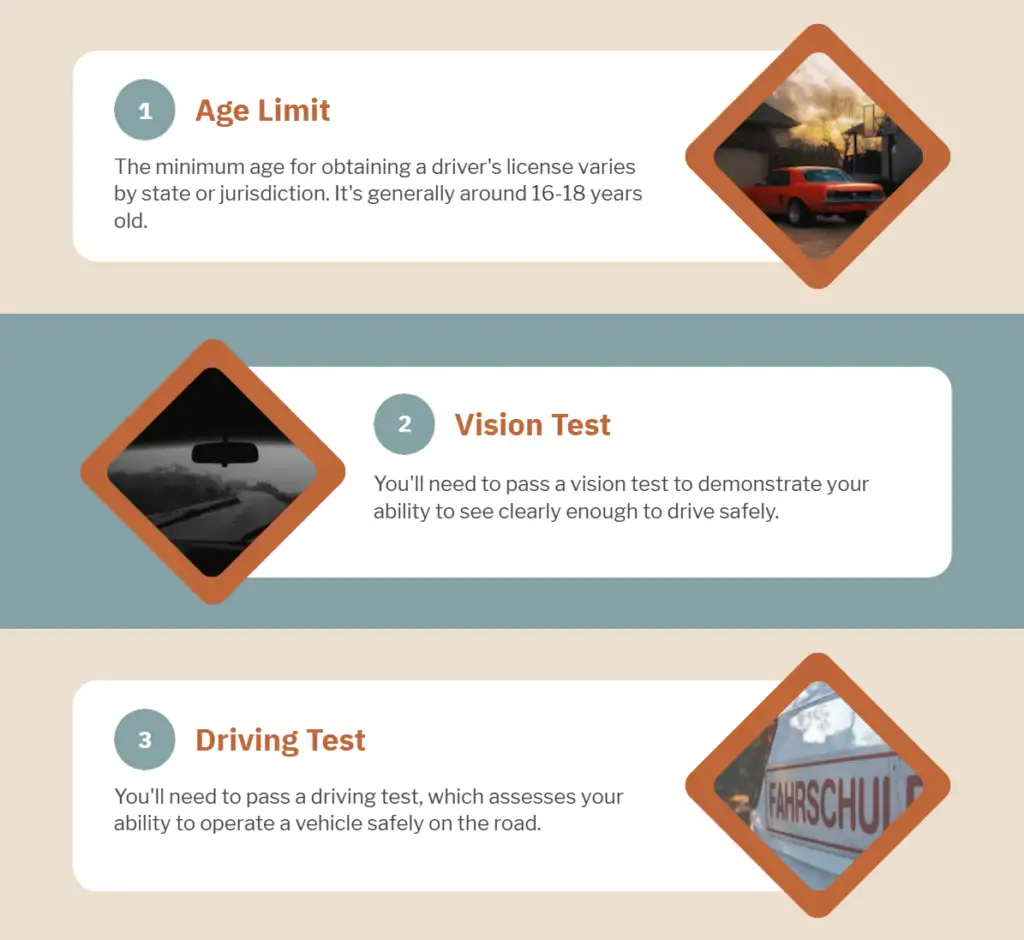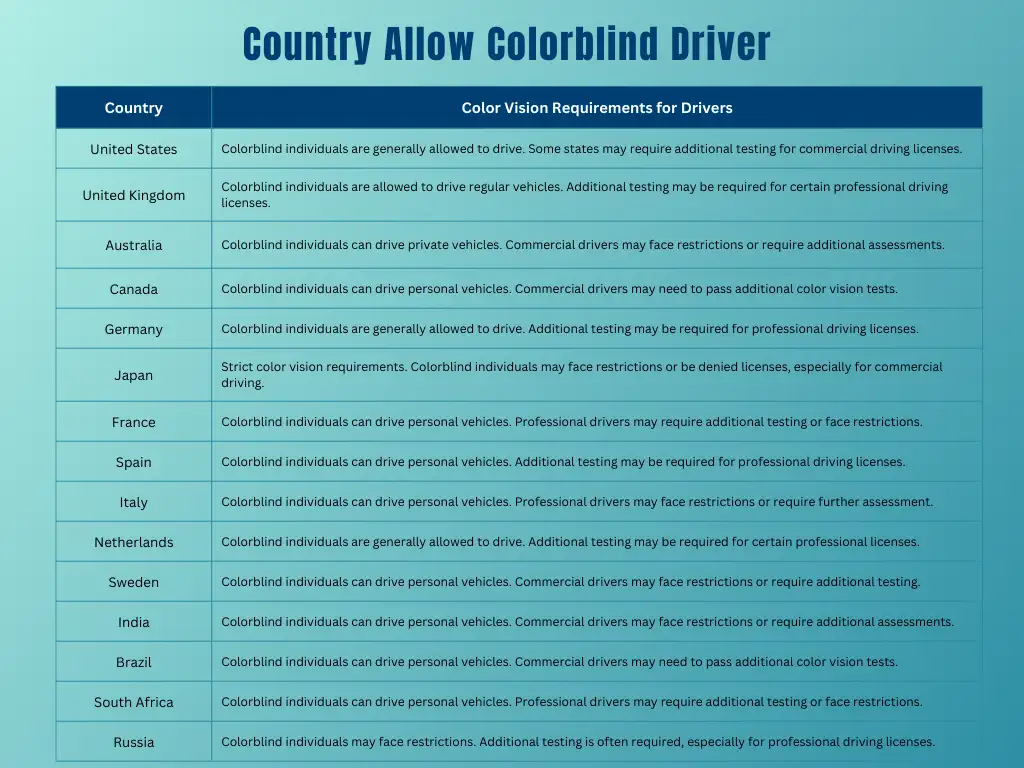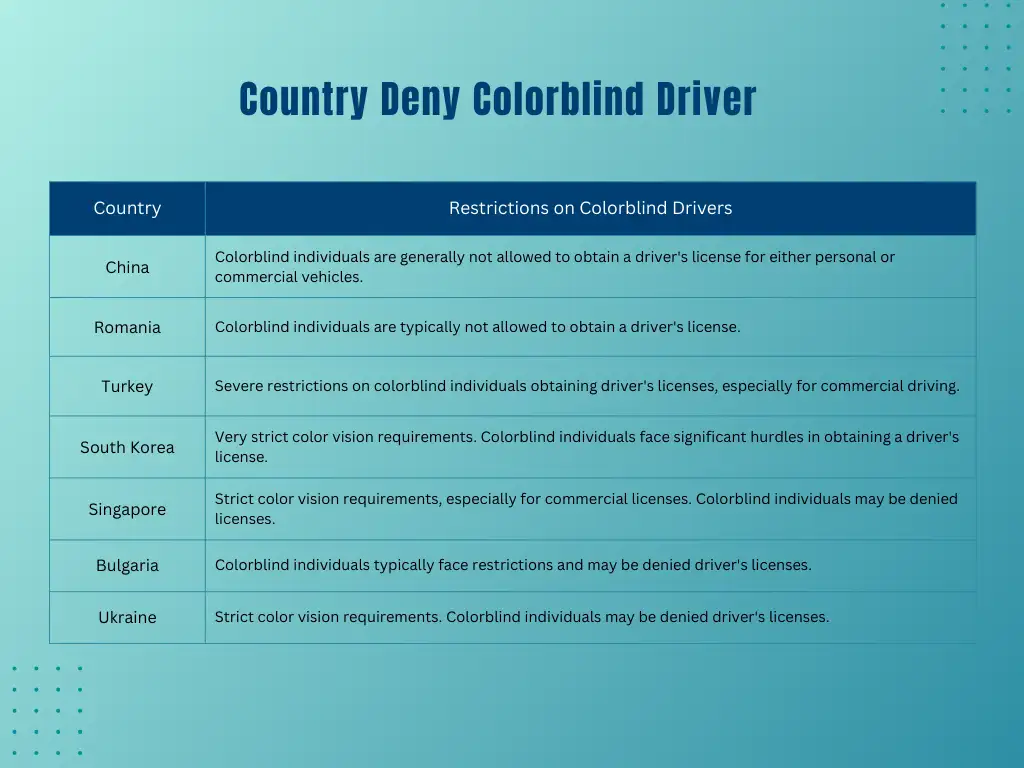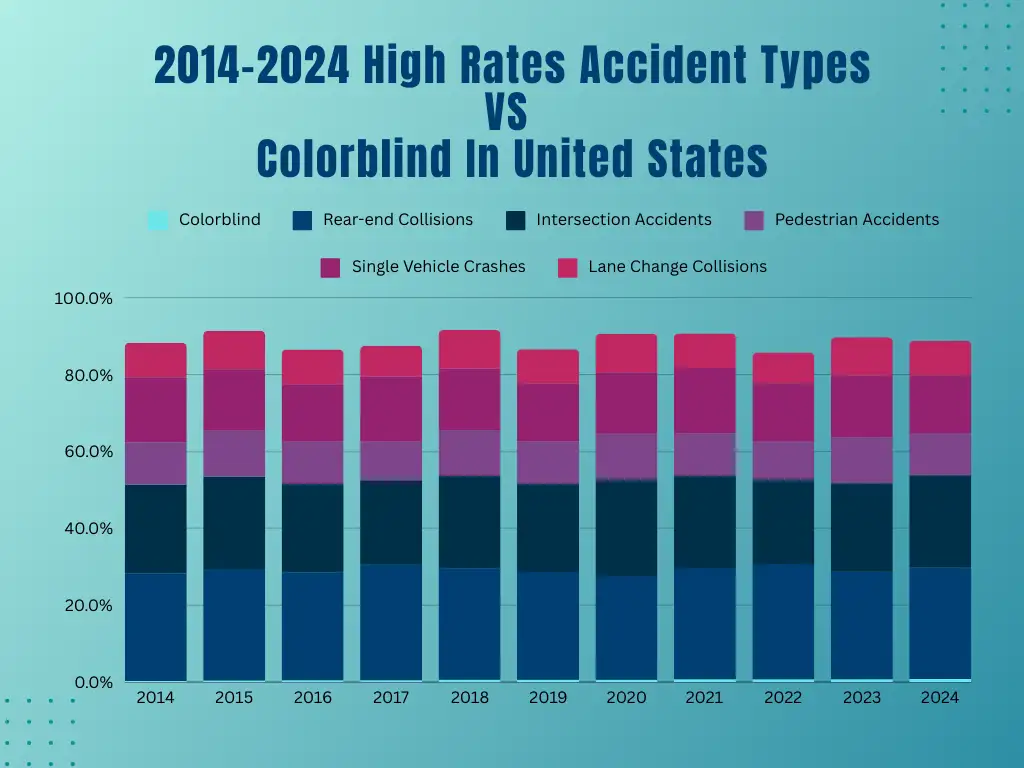Can Color Blind People Drive Safely on the Roads?
Many people wonder if color blind individuals can safely drive. The answer is yes; many color blind people can drive without issues. Color blindness affects the way a person perceives colors, but it does not necessarily prevent them from recognizing important signals on the road, like traffic lights.
Driving with color blindness can come with unique challenges, such as difficulty differentiating between certain colors. However, most color blind drivers learn to adapt to these conditions by using other visual cues and maintaining cautious driving habits. Understanding their limitations helps them manage their driving experience effectively.
Those considering the intersection of color blindness and driving will find that legal aspects and safety measures are crucial topics. Exploring these factors provides valuable insight into how individuals can navigate the roads confidently while being aware of their condition.
Key Takeaways
- Many color blind individuals can drive safely with proper adaptations.
- Color blindness does not lead to significant accident rates.
- Awareness and education can enhance driving safety for color blind drivers.
Understanding Color Blindness
Color blindness, or color vision deficiency, affects how individuals perceive colors. Different types of color blindness exist, each with its own implications for daily activities, including tasks like driving.
About 8% of men and less than 1% of women experience some form of color blindness. This condition often goes undiagnosed, with individuals learning to adapt to their color vision challenges.
Types of Color Blindness
Refers to the inability to perceive colors in the usual way. Here are four common types of colorblindness:

- Red-Green Colorblindness:
- Description: This is the most common type, affecting a significant portion of the population, primarily males. It includes two subtypes:
- Protanopia: The inability to perceive red light, leading to confusion between red and green.
- Deuteranopia: The inability to perceive green light, causing similar confusion between red and green.
- Visual Impact: Individuals may see red as dark or greyish and struggle to distinguish between shades of green and red.
- Description: This is the most common type, affecting a significant portion of the population, primarily males. It includes two subtypes:
- Blue-Yellow Colorblindness:
- Description: This type is less common and includes:
- Tritanopia: The inability to perceive blue light, which can lead to confusion between blue and yellow.
- Visual Impact: Individuals may see blue as greenish and yellow as a shade of grey or purple, making it difficult to distinguish between these colors.
- Description: This type is less common and includes:
- Monochromacy (Total Colorblindness):
- Description: This is a rare condition where individuals see no color at all, only shades of grey. There are two types:
- Cone Monochromacy: Individuals have only one type of cone photoreceptor, leading to a complete lack of color perception.
- Rod Monochromacy: Individuals rely solely on rod cells for vision, which are sensitive to light but do not detect color.
- Visual Impact: People with monochromacy perceive the world in black, white, and shades of grey.
- Description: This is a rare condition where individuals see no color at all, only shades of grey. There are two types:
- Anomalous Trichromacy:
- Description: This condition occurs when one of the three types of cone photoreceptors is present but functions abnormally. The three types include:
- Protanomaly: Reduced sensitivity to red light.
- Deuteranomaly: Reduced sensitivity to green light (the most common form of color vision deficiency).
- Tritanomaly: Reduced sensitivity to blue light.
- Visual Impact: Individuals can perceive colors but may have difficulty distinguishing between certain shades, particularly in the red-green or blue-yellow spectrum.
- Description: This condition occurs when one of the three types of cone photoreceptors is present but functions abnormally. The three types include:
Implications on Daily Activities
Color blindness can impact various aspects of daily life. In driving, individuals often rely on signals beyond color to identify traffic lights.
For many, the position of lights and their patterns become key indicators. Traffic signals have specific arrangements: for instance, the top light is always red, the middle is yellow, and the bottom is green.
Other areas affected include choosing clothing, reading certain materials, or interpreting graphs. Some individuals use aids, like color identification apps, to assist in these tasks. Understanding these implications helps in creating a more accommodating environment for those with color vision deficiency.
Legal Aspects of Driving With Color Blindness
Driving with color blindness raises important legal considerations. Different countries and regions have specific requirements for obtaining a driver’s license, including vision tests and regulations. Understanding these aspects is crucial for colorblind individuals and those interested in the topic.
Driver’s License Requirements
Many places allow individuals with color blindness to obtain a driver’s license. However, applicants may face additional evaluations during the licensing process. Some jurisdictions require them to pass specific vision tests to assess their ability to distinguish traffic signals.

The criteria for passing can vary widely. For example, some regions may accept the Ishihara color test, which identifies color vision deficiencies through colored plates. Others may utilize the Farnsworth-Munsell 100 hue test, which measures color discrimination more thoroughly.
If the tests show limitations in color perception, license restrictions might be imposed. These could include driving during daylight hours or avoiding specific duties, like operating emergency vehicles.
Vision Tests and Standards
Vision testing plays a crucial role in licensing procedures. It aims to ensure that all drivers can recognize essential road signals and signs. Requirements can differ based on local laws.
In many areas, standard vision tests evaluate overall visual acuity, including peripheral vision. Color vision tests might also be included to determine an applicant’s ability to differentiate colors. Passing these tests is essential for obtaining or retaining a driver’s license.
Adjunctive assessments, such as the Ishihara or Farnsworth-Munsell tests, help authorities gauge the severity of color blindness. Depending on the results, further evaluations may be necessary to ensure that the individual can drive safely.
Country Allow Colorblind Drivers

Numerous countries permit colorblind individuals to drive, recognizing that many have developed ways to cope with their condition. For instance, in the United States, laws vary by state, but many allow colorblind drivers to hold valid licenses, provided they meet other vision standards.
Countries in Europe have a similar approach. In the UK, color blindness does not automatically disqualify an individual from driving, as long as they can demonstrate suitable vision capabilities through testing.
Countries like Australia and Canada also have no blanket ban on colorblind drivers. Local regulations commonly consider overall driving abilities rather than just color perception. This inclusivity supports those with color vision deficiencies in participating in everyday life.
Country Deny Colorblind Drivers

Some countries impose stricter regulations. In certain areas, colorblind individuals face significant hurdles in obtaining a driver’s license. For example, countries with rigid medical standards may prohibit individuals with color blindness.
In South Korea, specific vision standards must be met, including the ability to differentiate colors. If one fails to meet these standards, driving privileges can be denied. This strict enforcement of regulations can limit mobility for those affected by color blindness.
Furthermore, some regions require individuals to disclose their color vision deficiency during the application process. Failure to do so could result in penalties, including the potential loss of driving privileges. Such methods aim to ensure that all drivers can safely navigate the roads.
Colorblind Are Not Significant Accident Rates
Studies show that colorblind drivers do not have significantly higher accident rates compared to those with normal color vision. This finding is important for understanding the driving capabilities of colorblind individuals.

To understand this better, let’s consider the types of accidents that frequently occur. Rear-end collisions, intersection accidents, pedestrian accidents, single-vehicle crashes, and lane change collisions consistently rank among the highest in terms of frequency. For instance, hypothetical data suggests that rear-end collisions account for approximately 29% of total traffic accidents, while intersection accidents contribute around 24%. These high-rate accident types are primarily influenced by factors such as distracted driving, speeding, and driver inattention, rather than color vision deficiency.
In contrast, the contribution of colorblind drivers to these accidents is minimal. Research indicates that colorblind drivers represent a mere 0.5% to 0.8% of total accidents. This is particularly noteworthy when we consider that even in categories like rear-end and intersection accidents, where color perception might seem crucial, the primary causes are often behavioral rather than perceptual. For example, a driver who is distracted by their phone or is speeding is far more likely to be involved in a rear-end collision than a driver who is colorblind.
Another review assessed various studies and found that many color-deficient drivers can adapt effectively. They often learn to recognize traffic signals and respond safely on the road, even without distinguishing certain colors.
Many colorblind individuals possess normal visual acuity and visual fields. These factors contribute to their ability to drive safely. Research supports the idea that having a color vision deficiency does not inherently make someone a dangerous driver.
In conclusion, while color vision deficiency can present challenges, it does not appear to significantly impact driving safety. This information helps to inform regulations and attitudes towards colorblind drivers, encouraging a more inclusive approach to driving licenses and safety assessments.
Adapting to Road Environments
Colorblind individuals can develop skills to navigate road environments effectively. They learn to interpret traffic signals and recognize road signs using various techniques to ensure safe driving.
Interpreting Traffic Signals
Traffic signals typically use color-coded lights: red for stop, yellow for caution, and green for go. For those with color vision deficiency, distinguishing these colors can be challenging.
To adapt, colorblind drivers can focus on the position and order of the lights. For example, the top light in vertical signals is red, while the bottom light is green. Familiarizing oneself with the layout of traffic signals helps reduce confusion.
Using defensive driving techniques also plays a crucial role. Drivers should stay alert and anticipate changes, especially at intersections. This proactive approach enhances safety despite potential color recognition issues.
Recognizing Road Signs
Road signs vary in shape and symbols, serving as critical information sources. Colorblind individuals often rely more on shapes and icons rather than color. For instance, stop signs are octagonal, while yield signs are triangular.
To support effective sign recognition, colorblind drivers can learn the meanings of common signs. They might keep a guide in their vehicle or refer to resources that provide clear descriptions.
In addition, understanding the context of signs, like speed limits and warning symbols, helps in safe navigation. Techniques such as memorizing the appearance of each type of sign improve overall road awareness and confidence while driving.
Navigating Challenges and Ensuring Safety
Driving with color blindness brings unique challenges, but many individuals successfully navigate the roads by using effective strategies. Awareness of safe driving practices and the use of technology can enhance safety for those with color vision deficiency.
Safe Driving Practices for the Colorblind
Color vision deficiency, especially red-green color blindness, can impact how a driver reacts to traffic signals and signs. To counter this, colorblind drivers often rely on visual cues beyond color. For example, they may memorize the order of traffic lights: red is at the top, yellow in the middle, and green at the bottom.
Understanding the shapes and positions of road signs is also critical. Drivers can memorize key signs and their meanings. They often use landmarks to help navigate and anticipate traffic changes.
Maintaining a safe distance from other vehicles allows for better depth perception and time to react. Regular practice in familiar areas can improve comfort and confidence behind the wheel.
Technological Aids and Modifications
Advancements in technology offer valuable assistance for colorblind drivers. Certain apps are designed to help identify colors and display information clearly. For example, smartphone applications can read and interpret traffic signal colors aloud.
Additionally, modifications to vehicles can improve safety. Colorblind Contact Lenses can make dashboard lights easier to see. Some drivers may choose to install enhanced lenses for better peripheral vision.
Using adaptive devices like audio signals at crosswalks can also aid in navigating busy streets safely. These tools help all drivers, including those with color vision deficiency, stay aware of their surroundings and maintain safety on the road.
Special Considerations for Professional Drivers
Professional drivers who are color blind face unique challenges. They must navigate various regulations and adapt their driving habits to ensure safety on the road. Understanding the impact of color vision on driving can help mitigate potential issues.
Commercial Driving and Color Vision
To obtain a commercial driver’s license (CDL), individuals often need to pass specific vision tests. These tests typically evaluate visual acuity and color recognition, which are vital for recognizing traffic signals and road signs.
Color blind drivers may struggle with traffic lights, especially distinguishing between red and green. This can be critical in situations like night driving when colors may appear muted. Adaptations, such as memorizing the locations of traffic lights and using technology, can enhance safety.
Additionally, certain commercial driving roles might have stricter vision requirements. For example, jobs that involve emergency response may require exceptional color discrimination. It’s essential for color blind individuals to be aware of these regulations and choose their driving careers accordingly.
Frequently Asked Questions
Driving can present unique challenges for color blind individuals. Many wonder about their ability to perceive traffic signals, night driving difficulties, and how color blindness affects licensing and safety adjustments.
Are color blind individuals able to perceive traffic signals correctly?
Color blind individuals can perceive traffic signals, but they may experience difficulties. For example, some may confuse yellow and green lights. Despite this, many navigate traffic successfully by relying on other cues and their driving experience.
Is night driving more challenging for those with color blindness?
Night driving can be more challenging for color blind drivers. Reduced light can make it difficult to distinguish colors. However, many color blind individuals adapt by paying attention to the position of signals and other visual cues instead of relying solely on color.
Does being color blind impact the ability to obtain a driver’s license?
Color blindness does not automatically disqualify someone from obtaining a driver’s license. Individuals must meet other vision requirements. As long as they can demonstrate safe driving skills, they are allowed to drive.
What adjustments do color blind drivers make to drive safely?
Color blind drivers often make several adjustments for safety. They learn to memorize the positions of traffic signals. Many also focus on road signs and symbols that do not rely on color for conveying information.
How is color blindness tested for driving requirements?
Testing for color blindness typically involves simple vision tests. These tests assess an individual’s ability to recognize colors. If a person meets the necessary standards, they can usually proceed with obtaining a driver’s license.
Can color blind drivers distinguish between brake lights and turn signals?
Color blind drivers often can distinguish between brake lights and turn signals. Brake lights usually shine brighter and are a different position than turn signals. Many rely on the brightness and location of the lights instead of their colors for recognition.
Data Sources for Traffic Accident Statistics:
- National Highway Traffic Safety Administration (NHTSA)
- Description: NHTSA provides comprehensive data on traffic accidents, including annual reports, statistics, and analysis of traffic safety.
- Website: NHTSA
- Federal Highway Administration (FHWA)
- Description: FHWA offers data related to highways, including traffic volume and accident statistics.
- Website: FHWA
- Insurance Institute for Highway Safety (IIHS)
- Description: IIHS provides research and statistics on vehicle safety, crash data, and trends in traffic accidents.
- Website: IIHS
- Centers for Disease Control and Prevention (CDC)
- Description: The CDC provides data on injury prevention, including traffic-related injuries and fatalities.
- Website: CDC – Motor Vehicle Safety
- Fatality Analysis Reporting System (FARS)
- Description: Managed by NHTSA, FARS provides data on fatal motor vehicle crashes in the United States.
- Website: FARS
Data Sources for Color Vision Deficiency:
- American Academy of Ophthalmology (AAO)
- Description: The AAO provides information on various eye conditions, including color vision deficiencies.
- Website: AAO
- National Eye Institute (NEI)
- Description: NEI offers information on eye health and vision disorders, including color blindness.
- Website: NEI
- Color Blind Awareness
- Description: This organization provides resources and information about color vision deficiency.
- Website: Color Blind Awareness
- Research Articles and Journals
- Description: Academic journals often publish studies on the impact of color vision deficiency on driving and safety. Searching databases like PubMed or Google Scholar can yield relevant studies.
- Vision Science Organizations
- Description: Organizations such as the Association for Research in Vision and Ophthalmology (ARVO) publish research related to vision and color perception.
- Website: ARVO







